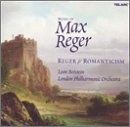| All Artists: Reger, Botstein, Lpo Title: Vier Tondichtung Nach Arnold Bocklin (Music Of Max Reger) (Reger & Romanticism) Members Wishing: 0 Total Copies: 0 Label: Telarc Release Date: 5/28/2002 Genre: Classical Style: Symphonies Number of Discs: 1 SwapaCD Credits: 1 UPC: 089408058929 |
Search - Reger, Botstein, Lpo :: Vier Tondichtung Nach Arnold Bocklin (Music Of Max Reger) (Reger & Romanticism)
 | Reger, Botstein, Lpo Vier Tondichtung Nach Arnold Bocklin (Music Of Max Reger) (Reger & Romanticism) Genre: Classical
|
Larger Image |
CD Details |
CD ReviewsReger in a Different Light Thomas F. Bertonneau | Oswego, NY United States | 08/02/2002 (4 out of 5 stars) "Leon Botstein has recorded a discography of unusual music for Telarc: the Schalk edition of Bruckner's Fifth Symphony, Dohnany's First Symphony, Szymanowski's Second Symphony, and Strauss's opera "Die Liebe der Danae." His most recent foray, a disc of romantic music by Max Reger (1873-1916), explores a side of that composer less well known than it ought to be. Connoisseurs will likely be acquainted with Reger as the neo-baroque composer of the Mozart and Hiller Variations and of large-scale works for the organ such as his Prelude with Passacaglia and Fugue. Dense counterpoint in strict patterns marks this aspect of Reger's work. The compositional virtuosity is perhaps summed up in one of Reger's verbal fillips. The inveterate joker sometimes signed himself as "Rex Mager," transposing the letters in his actual name. This gesture serves to remind us of all the canonic devices (inversions, retrogrades, and retrograde inversions) in Reger's music. Reger otherwise fits in with the Austro-German late-romantic esthetic, following Strauss in his over-saturated harmonies and, like Strauss, taking inspiration from literary and other non-musical sources. Botstein's program embraces three works: the "Four Tone Poems after Arnold Böcklin," the aria for soprano and orchestra after Hölderlin, "An die Hoffnung," and the Eichendorff-inspired "Romantic Suite." The romantic Reger is oddly a less outgoing figure than his neo-baroque alter ego, quieter, at times coming close to an impressionist style, nocturnal rather than sunny in his habits. Böcklin's name retains some of its currency: he painted large brooding canvasses on classical and myth-derived themes in a style related to that of the so-called academic painters of mid-nineteenth century in France and Britain. The first section of Reger's Suite, "Hermit Playing the Violin," is all minor keys and quiet, melancholy scene painting, with obligatory contributions from the solo fiddle. The second section, "In the Play of the Waves," is a brief seascape: Böcklin's original shows nereids and tritons floating in the surf and like everything he painted is suffused with an atmosphere of supernatural menace; Reger's music, in fast tempi to make a contrast with the foregoing movement, conveys something of this menace, combining it with the usual characteristics of a scherzo. The third section takes its cue from Böcklin's most famous painting, "The Isle of the Dead." (This is the painting that inspired Sergei Rachmaninov to a composition bearing the same name.) "The Isle" forms the heart of the Suite. The movement might best be described as a funeral procession heard at night in the distance. The concluding "Bacchanal" makes for an upbeat ending. The "Four Tone Poems" are definitely for listening late at night, ideally with good color reproductions of Böcklin's art at hand, and a glass of good wine. The song with orchestra, "An die Hoffnung," is Brahmsian and will remind auditors of Brahms' "Alto Rhapsody." (But there is no chorus.) The "Romantic Suite after Eichendorff" finds its germ in poetry rather than painting. Josef von Eichendorff appealed to many Teutonic composers of the Romantic period. Hans Pfitzner wrote a large-scale "Eichendorff Cantata" as late as 1921. There are three movements. As in the "Four Tone Poems" the mood is nocturnal, the harmonies are minor key, and the colors are properly subdued. Botstein's LPO strings are gorgeous throughout. The woodwinds make piquant contributions especially in the fast movements (the "Bacchanal" of the "Four Tone Poems" and the "Scherzo" of the "Romantic Suite"). Botstein's case is more persuasive to my ears in the "Four Tone Poems" than Neeme Järvi's on Chandos, coupled with one of the Franz Schmidt symphonies. I'm not sure that there's currently any competition in the "Romantic Suite." The sound is at once rich and transparent. This disc makes a nice complement to the recent Chandos issue of Reger's Psalm 100 and Mozart Variations, conducted by Valeri Polyansky. Recommended for connoisseurs of offbeat late-Romantic repertory."
|

 Track Listings (8) - Disc #1
Track Listings (8) - Disc #1